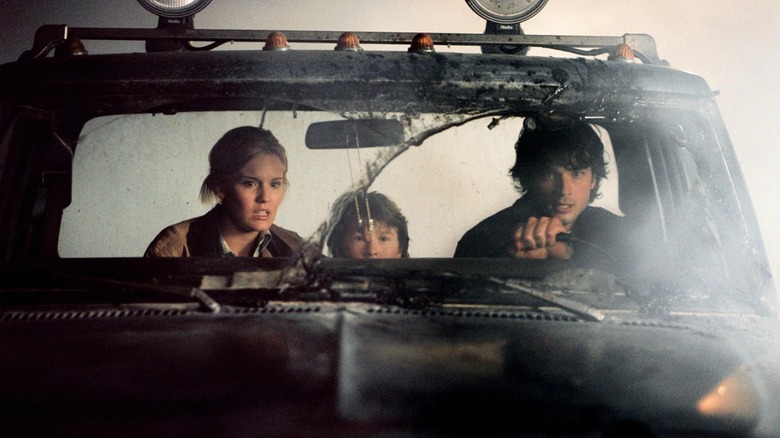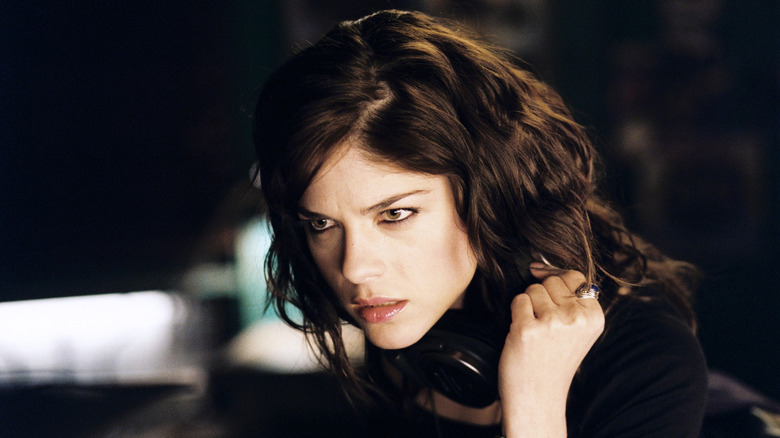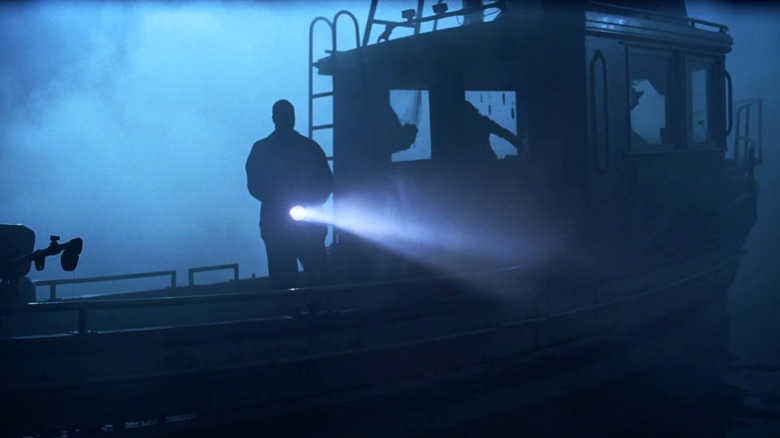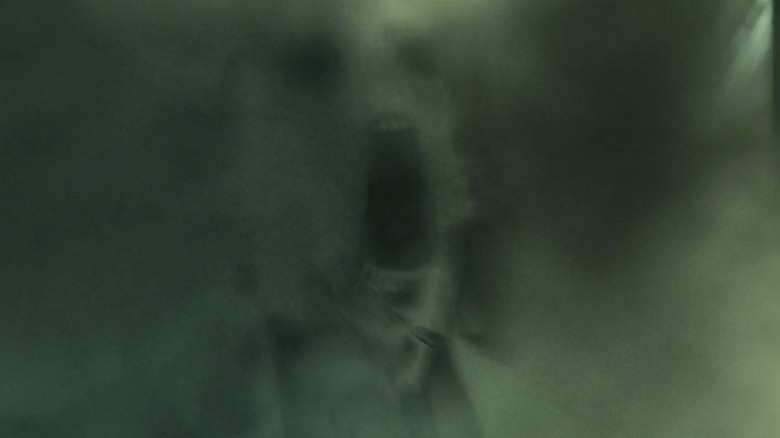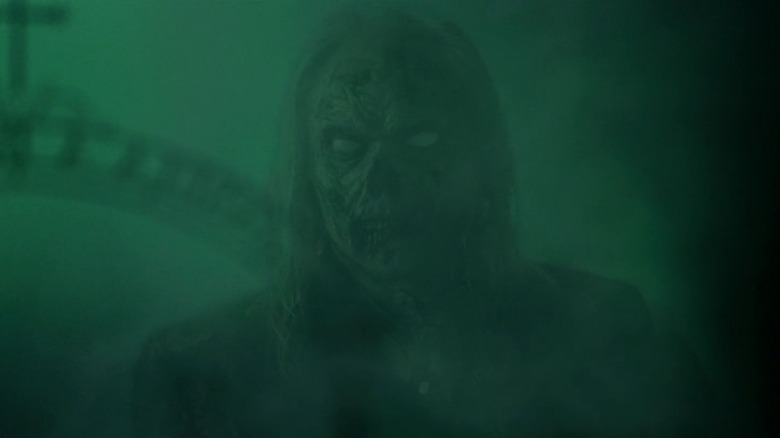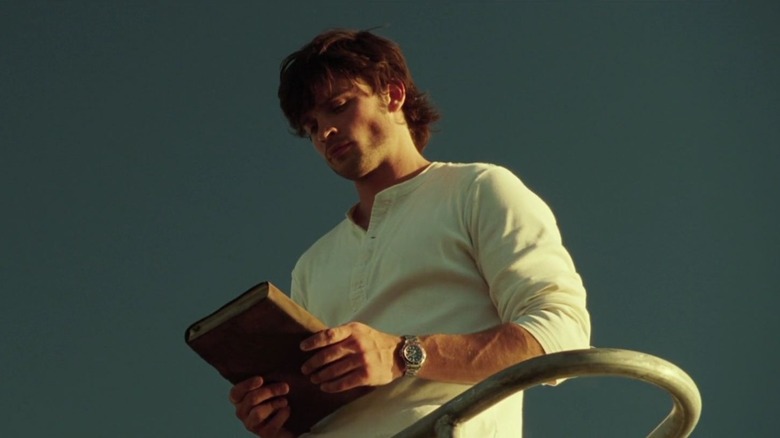A Maligned Horror Remake Starring Tom Welling Was A Baffling Box Office Success
(Welcome to Tales from the Box Office, our column that examines box office miracles, disasters, and everything in between, as well as what we can learn from them.)
"If everybody else is making remakes and they want to pay me money to make a remake of an old movie of mine, why not?" Those are the words of horror maestro John Carpenter speaking to IGN in 2005. At the time, we were still several months away from the release of "The Fog," a remake of his simple yet very effective 1980 ghost story.
Carpenter's original film was a decent hit and, though it paled in comparison to the monster that was "Halloween" from two years earlier, it remains a favorite within the filmmaker's catalog. In 2005, Sony Pictures set about remaking the movie with a bigger budget and a trendy cast that included "Smallville" star Tom Welling, "Hellboy" lead Selma Blair, and then-up-and-comer Maggie Grace.
The result? Quite arguably one of the worst horror remakes of all time. All the same, though it wasn't a big hit, it managed to make enough at the box office to be considered a success. That's pretty surprising, if not baffling, in hindsight.
In this week's Tales from the Box Office, we're looking back at the "Fog" remake in honor of its 20th anniversary. We'll go over how it came to be, what was going on in the realm of mainstream horror at the time, what happened when it hit theaters, what happened in the aftermath of its release, and what lessons we can learn from it all these years later. Let's dig in, shall we?
The movie: The Fog (2005)
The film as we know it follows the residents of the small town of Antonio Bay as they find themselves trapped in a mysterious mist on their way to becoming the unwitting victims of a horrifying quest for vengeance. Indeed, the souls of a ship that sunk 100 years ago are back and out for revenge against the descendants of those responsible for their deaths.
Carpenter and Debra Hill, who co-wrote 1980's "The Fog" alongside him, were both credited as producers on Sony's remake. However, it's worth looking at where Carpenter was at during this point in his filmmaking career. 1995's "Village of the Damned," itself a remake of a horror classic, bombed in theaters. That, in a lot of ways, marked a turning point for him as a director, as his best days would, unfortunately, prove to be behind him.
Carpenter was coming directly off 2001's "Ghost of Mars," another colossal flop. He was also just a handful of years away from helming 2010's "The Ward," which remains his most recent feature directorial effort. In short, the filmmaker was in something of a period of transition (or approaching one, anyway), so the idea of producing a remake of one his movies was appealing for several reasons — not the least of which was the paycheck.
"'The Fog,' I wrote the screenplay, so they actually have to pay me," Carpenter explained in a 2019 interview with Variety. "That's my favorite kind of remake, is to extend my hand and receive a check for doing nothing. That is a profession I can handle."
The Fog was part of the early 2000s horror remake trend
It's fair to say the remake wasn't something Carpenter was particularly passionate about, but he was more than happy to participate for the paycheck. Sony tapped Rupert Wainwright ("Stigmata") to direct the reimagining, working from a script by Cooper Layne ("The Core").
As for why Sony wanted to remake "The Fog" in the first place? This came about at a time when horror remakes were having a lot of success at the box office. Hollywood, of course, is generally keen on attempting to emulate success. 2003's "The Texas Chainsaw Massacre" made $108 million worldwide against a very reasonable $9.5 million budget. The remake of Tobe Hooper's seminal 1974 horror classic was quite popular, so others like it soon followed.
Earlier in 2005, even the largely maligned remake of "The Amityville Horror" (starring Ryan Reynolds) made $109 million globally, which helped keep this remake trend going. Sony was looking to execute from that same playbook. It hired a CW star in Tom Welling, just like Jessica Biel ("7th Heaven") was recruited to star in "Texas Chainsaw" and Jared Padalecki ("Supernatural") would eventually go on to headline the 2009 "Friday the 13th" remake ($91.5 million worldwide).
There was undoubtedly a formula to these things at the time that was working over and over again. Sony had every reason to think this was a good idea. Keep in mind, this was several years before Netflix would even offer streaming. The company was still a DVD by mail service back then, while physical media was a much bigger deal. People still went to the movies just to go to the movies. It was, in many ways, far easier to make money with a reasonably budgeted film back then.
The Fog remake goes bigger (but not for better)
Carpenter's original version of "The Fog" was inspired by a trip to Stonehenge, which was then fleshed out into a full screenplay. It's a tight 90-minute movie. The remake, however, sought to expand upon and flesh out the story a bit, clocking in at 100 minutes. It's proof positive that bigger isn't always better. Speaking of bigger, Carpenter made the original film on a shoestring budget of just $1.1 million. Even adjusted for inflation, that would be less than $5 million. By Hollywood standards, that's nothing.
Wainwright's remake, on the other hand, cost $18 million to produce. That would be about $30 million in today's dollars. But while it's a much more expensive movie (and this is important), it's still on the lower end for a major studio project. Hollywood has consistently invested in horror because it can be made on the cheap. Relatively low risk with high reward potential. During a set visit, Wainwright explained how he approached the story (via Dark Horizons):
"A lot of this movie is really about the heritage of the town. Before, the journal was found in a church, so it's centered around the church. In our version, one of the things that we really focus on is sort of the nexus of the past and the present, and how the past has come back to basically destroy the present because of what happened then."
At the very least, Wainwright had a concept to help distance the remake from its predecessor. Unfortunately, the end result left much to be desired.
The financial journey
Critics of the day savaged the film. "The Fog" holds an abysmal 4% approval rating on Rotten Tomatoes. "Making concessions at every turn to the youth-horror market, the film slashes the ages of its protagonists by some 15 years, and its IQ follows suit," wrote R. Emmet Sweeney for The Village Voice at the time.
Be that as it may, Sony had a movie to sell. What it sold was a relatively generic ghost story that could appeal to younger viewers at the time. The studio wasn't necessarily going for the older crowd that may have seen the original film in their youth. In that regard, Sony succeeded, as it overcame those absolutely lousy reviews and emerged on the other side with a number one movie.
"The Fog" hit theaters on the weekend of October 14, 2005, just in time for the Halloween season. It proved to be a good launch pad for the film, as it opened atop the charts in North America with $11.7 million. That was far from a massive opening, but it was good enough, particularly for a movie with such a stink on it. The remake was also helped by the lack of major competition, with "Elizabethtown" ($10.2 million) and "Domino" ($4.6 million) serving as the two other new releases that weekend.
Helping matters further, "Doom," one of the worst video game movies ever, opened one week later, which helped the "Fog" remake hold decently with a $6.6 million second weekend. Eventually, "Saw II" swooped in to steal its thunder on Halloween weekend, but by that point it didn't matter all that much. Sony had gotten away with one.
The "Fog" remake finished its run with $29.5 million domestically to go with $16.6 million at the international box office for a grand total of $46.2 million worldwide.
The Fog was barely a hit, but even that is surprising
To be clear, this movie was far from a big hit but, particularly by 2005 standards, it was a modest success nonetheless. Using some traditional rule of thumb box office math, the general thinking was that if a movie could earn 2.5 times its production budget, it would make its money back. Even if it didn't profit from its theatrical run alone, it got close. And as mentioned, the home media market was extremely helpful at that time. To that end, the DVD release brought in at least $15 million in the U.S. alone. That's to say nothing of cable rights and eventual streaming rights over the years.
For the sake of comparison, Carpenter's "The Fog" made $21.4 million in theaters against its minuscule budget and has since benefited from VHS, DVD, Blu-ray, and even a 4K release in theaters back in 2018. It's had real staying power thanks to a reputation that has grown over the years. So, it's no contest when it comes to which version of "The Fog" was more successful.
That having been said, the remake's reputation is nothing shy of lousy. Rightfully so. I'll be honest; I was surprised to discover that this movie wasn't an outright flop in its day. The fact that it was even moderately successful is nothing shy of eyebrow-raising. It's a testament to just how different things were 20 years ago. Even a downright terrible film could top the box office and squeak out some profit, for better or worse.
The lessons contained within
When Carpenter made "The Fog," he wanted to do something different from "Halloween," rather than repeat himself. At the time, the film wasn't nearly as successful as "Halloween" but it was successful nonetheless, and its reputation only grew over the years. That allowed Carpenter to spread his wings beyond masked killers. It's also a big part of the reason why he didn't direct "Halloween II."
The "Fog" remake, on the other hand, was nothing shy of a cash grab. It was an attempt to appeal to young people with an old idea as part of a current industry trend. Though it would be unfair to place the whole affair on his shoulders, it's perhaps telling that Wainwright hasn't directed another feature film in the 20 years since then.
That's not to say remakes are a bad idea. There are tons of great ones out there. Heck, Carpenter's own "The Thing" was itself a remake and is nothing shy of a horror masterpiece. But pretty much every worthwhile remake needs a reason to exist beyond making money, e.g. some creative flourish that allows it to stand on its own two feet (or even simply a fresh way to present an old story to a new generation). "The Fog" did just enough of that to squeak by without flopping, but it had more to do with the industry at the time than its own creative merits.
Back then, home media was a much bigger and more reliable safety net. DVD sales could rescue a movie from the depths of hell. Streaming royalties aren't nearly as big and yes, VOD has helped the film industry, but those post-theatrical revenue streams have dried up a great deal. Would-be catastrophes like this can't rely on such saving graces anymore.
